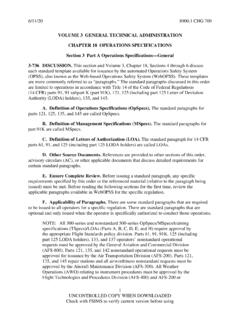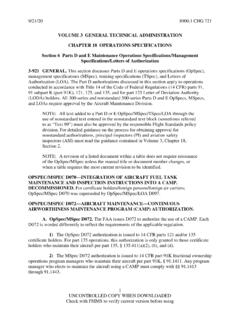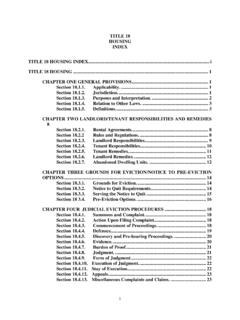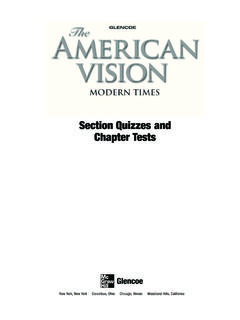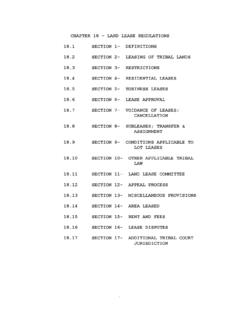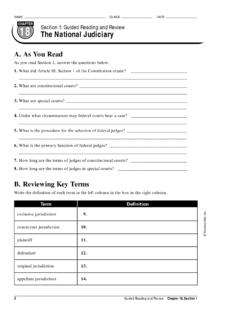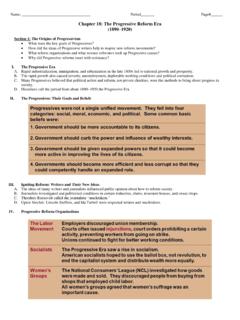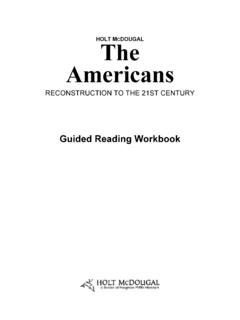Transcription of Chapter 18: The Cultural Geography of North Africa ...
1 GeoJournalAs you read this Chapter , use your journal to note the ethnic diversity of North Africa ,Southwest Asia, and Central Asia. Recordboth similarities and differences among thepeoples who inhabit this OverviewVisit the Glencoe WorldGeography Web site at click on Chapter Overviews Chapter 18 to preview information about the Cultural Geography of the to ReadingConsider What You KnowAs you know, the region of NorthAfrica, Southwest Asia, and CentralAsia is made up of a variety of physi-cal features and climates.
2 Many dif-ferent peoples live in the does the diversity of ethnicgroups affect life in North Africa ,Southwest Asia, and Central Asia?Read to Find Out How have movement and inter-action of people in the region led to ethnic diversity? How do the region s seas, rivers,and oases influence where peoplelive? What effect does the growingmigration into the cities have on the region?Terms to Know ethnic diversity infrastructurePlaces to Locate Tu r ke y Afghanistan Armenia Georgia Kazakhstan Tajikistan Uzbekistan TehranChapter 18439El Faiyum oasis, EgyptPopulation PatternsA Geographic ViewRefuge of PeoplesA refuge since the last period ofEurasian glaciation, the Caucasusregion has been a gateway fortravel, trade, and conquest.
3 [Despite the numerous power struggles] the Caucasus hasremained a [stronghold] of peo-ples whose identities are tied to the 50-some languages theyspeak.. The persistence of theenduring identities of ethnicgroups has been aided by therugged terrain and by societieswhose loyalties are to clanand family as much as tonation or region. Mike Edwards, The Fractured Caucasus, National Geographic, February 1996 Like North Africa , Southwest Asia,and CentralAsia as a whole, the Caucasus area has long been home to manypeoples.
4 Some of these peoples vanished long ago defeated inwars, wiped out by famines, or absorbed by more powerful have survived for hundreds of years and flourish todaybecause of contact with travelers, merchants, and conquerors fromdistant places. The result is a tapestry as rich and varied as theregion s much-sought-after PeoplesThe region of North Africa , Southwest Asia, and Central Asia hasserved as the crossroads for Asia, Africa , and Europe. As a result, theregion has remarkable ethnic diversity, or differences among groupsbased on their languages, customs, and in the Caucasus440 Unit 6homeland.
5 Over the centuries, wars, persecution,and trade led many Jews as the descendants ofthe Israelites are called to settle in other coun-tries. Their religious identity, however, kept alivetheir link to the ancestral homeland. Finally, in1948, Israel was founded as a Jewish state. Todayhalf of Israel s Jews were born in Israel, and halfhave emigrated from Arabs of the region, however, did not wanta Jewish state in territory that had been theirhomeland for centuries.
6 Tensions between Arabsand Jews resulted in four wars that broughtsevere hardship to all the people of the area,including the Palestinians Arabs living in theterritory in which Israel was established. Duringthis period of conflict, many Palestinians weredisplaced from their homes and lived in refugeesettlements in neighboring Arab agreements between Israeli and Palestinianleaders have led to greater Palestinian , peace is still elusive. Issues such as theownership of the Old City of Jerusalem, the returnof Palestinian refugees, and ownership of water andother natural resources remain people of the region about275 million are Arabs.
7 Most Arabsare Muslims, followers of thereligion of Islam, but a small percentage followChristianity or other religions. Both Islamic cultureand Arabic, the language of the Arabs, have had asignificant impact in this the spread of Islam in the 600s, Arabic-speaking peoples inhabited the Arabian Peninsulaand a few areas to its North . Many Arabic-speakingpeople today, however, descend from ancient groupssuch as the Egyptians, Phoenicians, Saharan Berbers,and peoples speaking Semitic languages.
8 Currently,Arabs live in 16 countries, including Libya, Tunisia,Algeria, and Morocco the countries known as theMaghreb the West in million people of the region areIsraelis living in Israel. Of these, 82 percent areJewish. The remaining 18 percent are mostly Arabswho are Muslim or Christian. Jews living in Israel and elsewhere trace theirreligious heritage to the Israelites, who in ancienttimes settled Canaan, the land shared today byIsrael and Lebanon.
9 The Israelites believed thatGod had given them this area as a permanentBedouins inTunisiaBedouins, or nomadic Arabs, live in the desert areas ofNorth Africa and Southwest countries are part of the Maghreb? Chapter 18441 Student Web ActivityVisit theGlencoe World GeographyWeb site at click on Student WebActivities Chapter 18 for an activity about visiting Egypt scultural and historic the past 8,000 years, many peoples haveoccupied Anatolia, the Asian part of what is todaythe country of Turkey.
10 Each group added its owncustoms and beliefs to the Cultural blend. Turkicpeoples migrated to the peninsula in the 1000sfrom Central Asia. One Turkic group, known as theOttoman Turks, later built the Ottoman Empire,which ruled much of the eastern Mediterraneanworld for more than 600 years. When a group ofTurkish citizens was asked to define who a Turk istoday, one of them responded this way: I don t believe anybody is Turkish ,whatever that means, he said. Then ,swinging his arms to take in the lunchcrowd, he exclaimed, Look at us!

